For this edition of GP’s Classic Steel, we are going to take a look back at the 125 class of 1991.
For this edition of GP’s Classic Steel, we are going to take a look back at the 125 class of 1991.
In 1991, the 125 class was still the most popular in motocross. The four-strokes were still a decade away from invading the tiddler class and the mere mention of racing a 250 thumper against the smokers would have gotten you laughed back to your Isuzu Amigo. It was a two-stroke world, and the 125 was the ultimate expression of smoker goodness. It was light, inexpensive, easy to work on and fun to ride. A cool $3400 bought you a bike that could be raced all year with minimal expense and repaired easily with a modicum of mechanical aptitude.
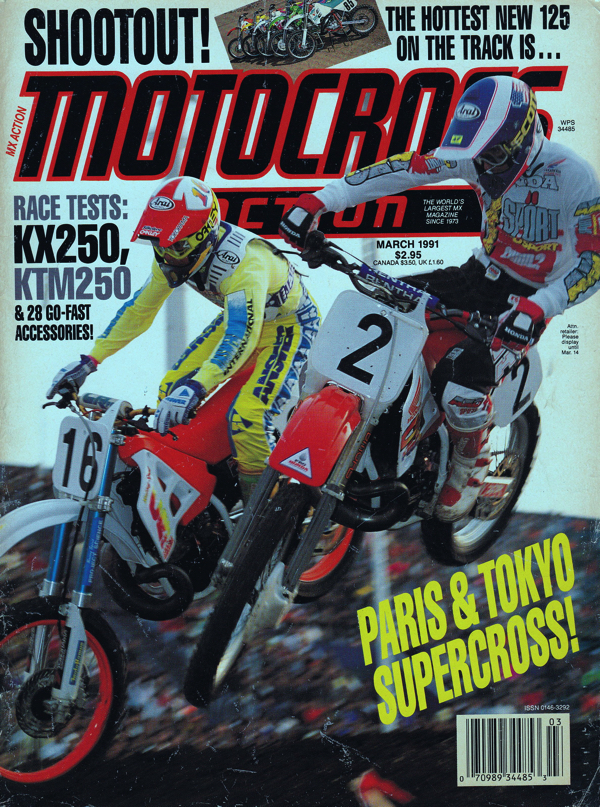 |
|
You can tell offseason racing was big in the early 90’s, as the hotly anticipated MXA 125 shootout is relegated to a tiny portion of the upper front cover in favor of a shot of Jeff Stanton from Tokyo. On a side note, check out #16’s Honda. It looks like he finally got sick of his Honda’s gruesome forks and actually bolted on a set of Kawasaki KYBs in their place. |
While all the 125s of 1991 made pretty good play bikes, only a few achieved the status of true thoroughbreds. Some were fast, but handled poorly, while others clung to the track like Spiderman, but lacked the ponies to outrun a Honda Mini-Trail 50. The crazy graphics craze was just starting to take hold in 1991 and all the bikes offered bold colors and outlandish styling. Tiger stripes? Check. Minty green check marks and yellow leopard spots? Oh yeah, we got you covered. I have no real clue why this took off, but it certainly made bikes from this era unique.
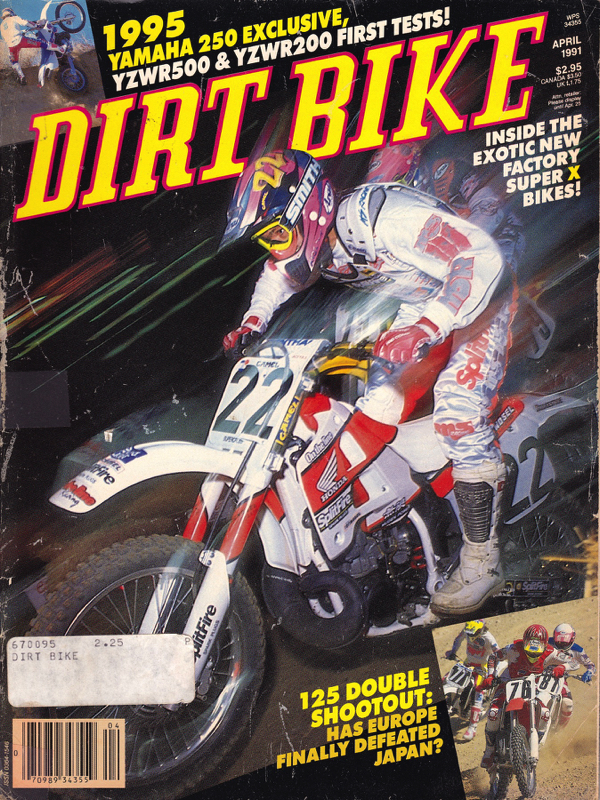 |
|
Once again, the illustrious 125 Shootout is relegated to a small corner of the cover and must play second fiddle to Ty Davis and his badass On The Line Racing Honda CR250R. |
For this installment of the shootout rundown, we are going to stick to Dirt Bike, MXA and Dirt Rider. By 1991, Super MotoCross and Moto Cross magazine were pushing up daises and MX Racer and Transworld MX were not yet a twinkle in Donn Maeda’s eye. This left Dirt Rider, MXA and Dirt Bike as the only MX games in town. Thankfully, the early nineties were a great time for the mags, and all three shootouts were thorough and comprehensive. Perhaps the most interesting of all, not a single one of them agreed on the same victor.
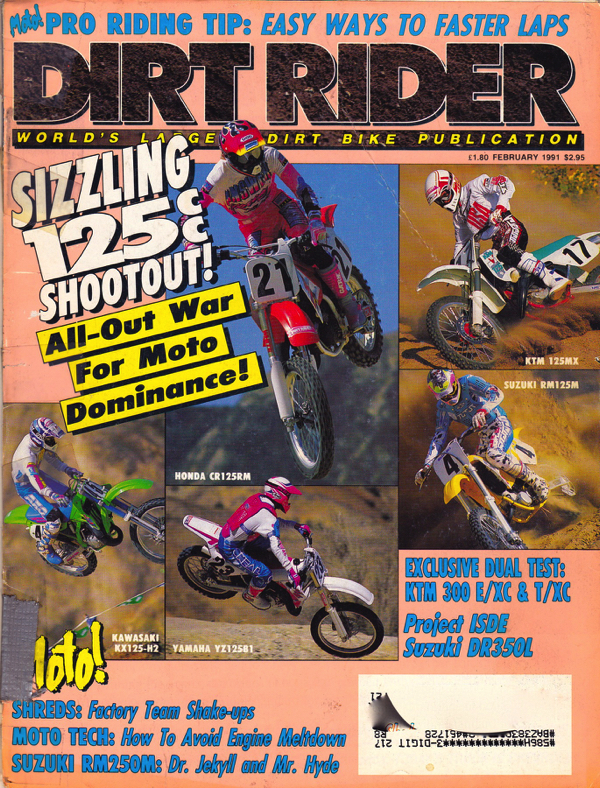 |
|
Now THIS is how you do a proper shootout cover. None of this stupid tiny photo nonsense for Dirt Rider my friends. Instead, they are big and bold as the Shootout Gods intended. |
Whether that was due to parity at the top or mediocrity overall was debatable, but in either case, it was clear that 1991 held no clear-cut winner. With the table set, it’s once again time to step into the Wayback Machine and see who ripped, and who tripped, in 1991. So bust out those Hammer pants, dust off that Ratio-Rite and crank up the C+C Music Factory, because we are heading back to the era of Designing Women and Desert Storm.
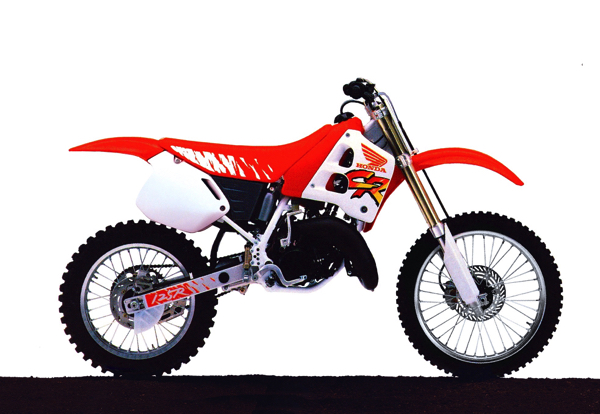 |
|
1991 Honda CR125R Shootout Ranking – MXA 2nd (out of five) – Dirt Bike 1st (out of four) – Dirt Rider 3rd (out of five) |
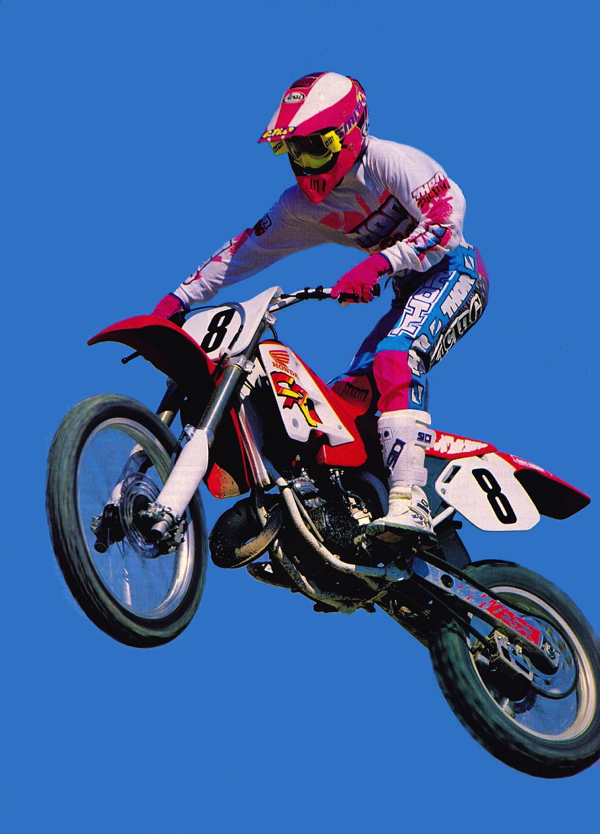 |
|
Fast but flawed, the pro-focused CR125R got mixed reviews in 1991. Photo Credit: Dirt Rider |
1991 Honda CR125R overview: In 1991, the CR125R was one of the more polarizing bikes in the shootout. What it did well, it did really well, but what it did poorly, well, let’s just say people still have bad dreams about its spooky high speed manners and grimly-damped forks. It was the fastest bike in the class by a wide margin, but also tricky to keep on the pipe and prone to bogging for those less talented. Poor jetting and an annoying popping on top-end also detracted from the Honda’s plus column.
Its power was focused nearly entirely on the top end and it lacked the low-end and midrange torque of the Kawasaki and Suzuki. Once it was on the pipe, however, it waived sayonara to the other four machines. Handling in the turns was sharp, but the CR shook its head at speed like a Sherman Williams paint mixer with a bad bearing. The harsh forks and shock were also panned by all and only beat out the KTM’s grim White Power units in the overall standings. Overall, it was a pro-focused package that rewarded bravado, but punished timidity. For Dirt Bike, its awesome motor and overall quality were enough to push it to the top, but for MXA and Dirt Rider, its abusive suspension and demanding power were too much to overlook.
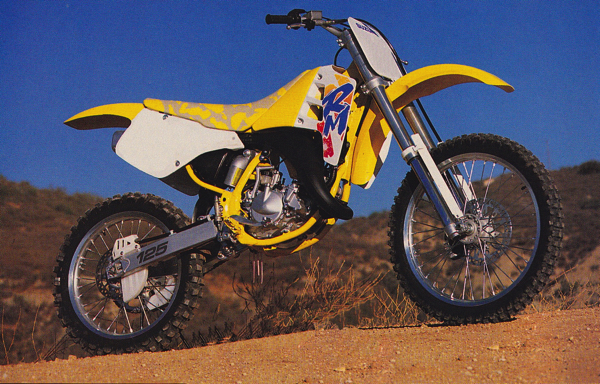 |
|
1991 Suzuki RM125 Shootout Ranking – MXA 3rd (out of five) – Dirt Bike 2nd (out of four) – Dirt Rider 1st (out of five) |
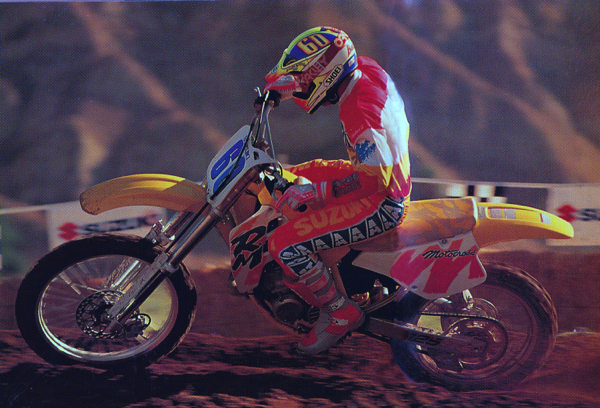 |
|
Under the hand of a skilled pilot like Buddy Antunez, the 1991 RM125 made a lethal Supercross weapon. Photo Credit: Suzuki |
1991 Suzuki RM125 overview: With its ultra-responsive motor and razor-sharp manners, the 1991 RM125 was one of the most fun-to-ride bikes on the track. Subtle changes to the motor yielded a snappy and abrupt powerband that got up and went at the first crack of throttle. No bike in ’91 was as quick out of the hole as the punchy RM. Once past the midrange, however, the Zook laid down and demanded another shift. It had virtually no top end and had to be short-shifted to make the best time. There was also a nasty bog when landing from mega leaps and an annoying sputter in the whoops. By far the RM’s best motor trait was its instant response and strong torque (for a 125); it made the RM fun on tight tracks and easier to keep on the pipe than the rev-happy CR.
The RM’s handling was Supercross focused and its turning was the tightest in the class. Stability was predictably less than stellar and the machine offered a generally unplanted feel at speed that made you pucker up and pray for the next set of slow switchbacks. The RM’s excellent ergos and punchy delivery gave it a light feel and the Zook proved the best leaper in the class. The new Showa suspension also offered more adjustment and a much better ride than the Showa units found on the Honda. Fork control was excellent and they provided a plush ride that rivaled the sterling KYBs found on the Kawasaki. The shock was not quite as universally praised and some riders found it slightly choppy.
Overall, the new RM was an excellent Supercross weapon that got a little sketchy once the speeds crept up. Its lack of top end and schizoid high-speed manners held it back from a unanimous victory in 1991. For Dirt Rider, its snappy motor, excellent forks and feather-light feel were enough to best the others. For MXA and Dirt Bike, the RM’s short powerband and twitch-o-matic handling pushed it out of the top spot.
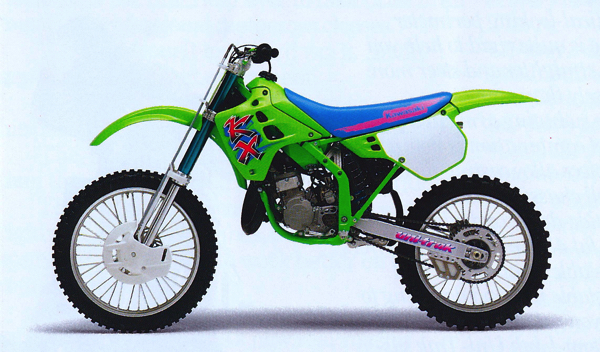 |
|
1991 Kawasaki KX125 Shootout Ranking – MXA 1st (out of five) – Dirt Bike 4th (out of four) – Dirt Rider 2nd (out of five) |
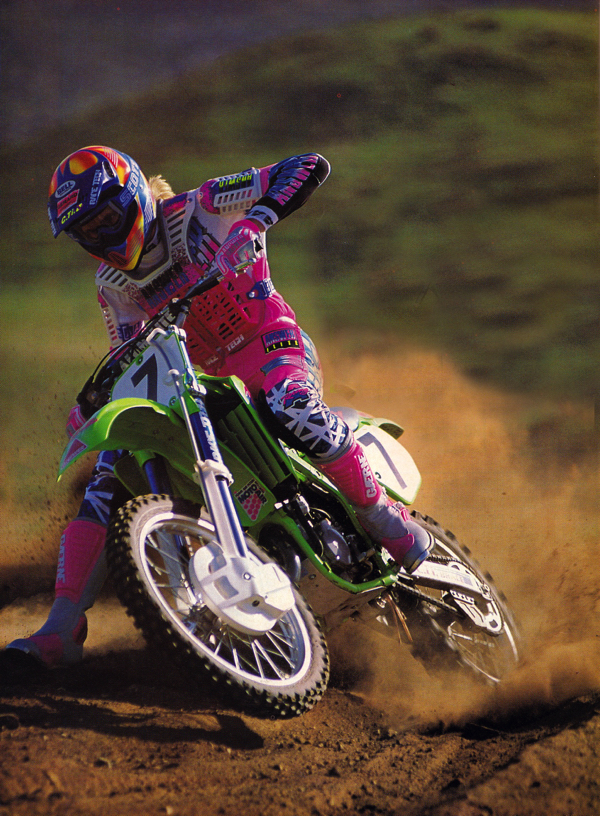 |
|
For tall guys like Tim Telford, the KX worked well, but its big feel and punchy powerband were an acquired taste for others. Photo Credit: Dirt Rider |
1991 Kawasaki KX125 overview: With the best suspension in the class, the KX125 had a lot of supporters in 1991. An ultra-plush shock and excellent Kayaba forks swallowed up track obstacles with ease. Unlike most of the other bikes, the KX was able to handle a wide variety of weight and skill levels with only a spin of the dials.
Unfortunately, that unanimous praise did not continue to the rest of the bike. The perimeter chassis, while admirably stiff, was tall, wide and bulky. Bodywork was likewise oversized and the KX felt more like an underpowered 250 than a nimble 125. The KX was pudgy in the middle and as Dirt Bike noted, bowed out at the shrouds like an “overstuffed taco.” The bike also felt heavier than the other machines, particularly at the handlebars. The hefty feel carried over on the track, where the Kawasaki took more effort to manhandle than the other bikes and preferred to ricochet off berms instead of diving to the inside. It was much more stable in the rough than the CR or KX, but not quite as rock-solid as the YZ.
The motor was also a point of contention, as some (MXA) found its hard-hitting midrange power to be a blessing, while others (Dirt Rider and Dirt Bike) lamented its relative lack of breadth. The KX offered the most potent midrange, but absolutely no bottom end and very little overrun on top. It was fast in its narrow band, but difficult to keep percolating. Making matters worse were its heavy clutch pull and cranky gearbox.
Overall, it was very good package if you were taller than the average tiddler pilot and favored suspension performance over ease-of-use. It was big, stable and punchy, but slightly clumsy in the tight stuff and demanding to ride fast. For MXA, the barky midrange and excellent suspension outweighed its big feel and narrow power spread. For Dirt Rider and Dirt Bike, the excellent suspension was just not enough to offset its other shortcomings.
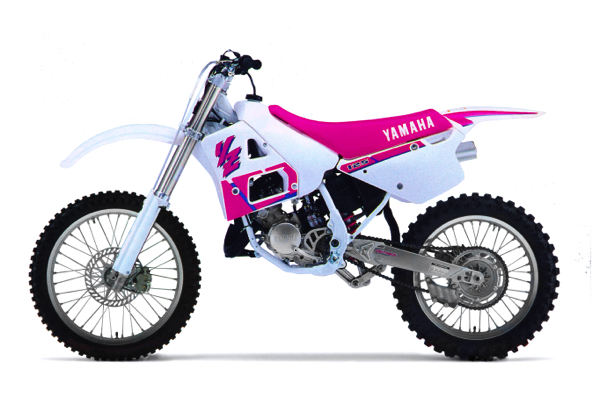 |
|
1991 Yamaha YZ125 Shootout Ranking – MXA 4th (out of five) – Dirt Bike 2nd (out of four) – Dirt Rider 4th (out of five) |
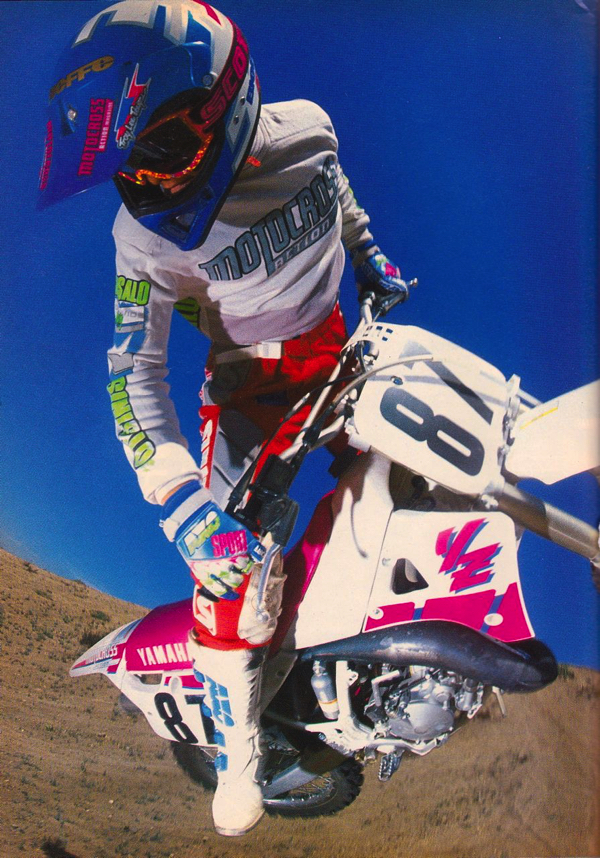 |
|
In 1991, BOLD NEW GRAPHICS and a sweet coat of magenta paint were not enough to camouflage a major pony deficit in the Yamaha camp. Photo Credit: Motocross Action |
1991 Yamaha YZ125 overview: In 1991, no bike in the business was the butt of as many jokes as Yamaha’s poor little YZ125. Never an outright powerhouse, at least it had been a competitive 125 mount the previous five years. Originally introduced in 1986, the YZ’s case-reed mill was best known for its strong midrange and abrupt delivery. It was fast, but short on breadth, requiring two shifts for every one necessary on a Honda.
For 1991, that all went out the window with a new YZ that kept the narrow power spread, but lost the punch somewhere on the way to production. Early test units got rave reviews, but once the YZs started rolling off the assembly line, the horsepower was MIA. In stock condition, the Yammer produced a narrow and flighty spread of power that made noise, but produced little forward motion. There was virtually no torque and very little hit to its anemic powerband, just a long and uninspired whine as it struggled to get out of its own way. On hard pack, it could maintain a decent pace, but once the YZ hit a little loam, it was bog city.
As soon as the bikes hit the street, Yamaha was quick to come out with Wrench Report mods to try and cure its wimpy powerband. Reed mods, hacksawed expansion chambers and swapped ignitions were all common surgeries performed on the YZ125 in 1991. Unfortunately, no amount of massaging was sufficient to bring it up to snuff with the other bikes in the class. No matter what you did, it still remained slow.
While Yamaha dropped the ball on the motor, the rest of the bike was quite good. The new chassis was loved by all and proclaimed the best handling YZ125 ever (the lack of forward thrust may have contributed to this). Suspension performance was mid-pack, with a better ride than the harsh Honda, but not as much plushness as the Kawasaki. The shifting continued to be cantankerous and only made the YZ’s narrow power spread more infuriating.
With its lack of power, it was not surprising that the YZ finished near the back of the pack in MXA and Dirt Rider’s rankings. What was shocking was that Dirt Bike ranked it SECOND over the RM and KX. In fairness, this discrepancy may be explained by the fact that Dirt Bike’s YZ test bike turned out to be a bit of a ringer. Before the shootout, their test machine had the Wrench Report mods performed on it by Yamaha. I don’t think there can be any doubt that this helped the terminally pokey YZ in the final standings. This modded machine was snappier and easier to ride than the pathetic stock Y-Zed and while still not as fast as the other bikes, it was at least no longer an embarrassment. Without these mods, the poor YZ was doomed to the bottom of the heap.
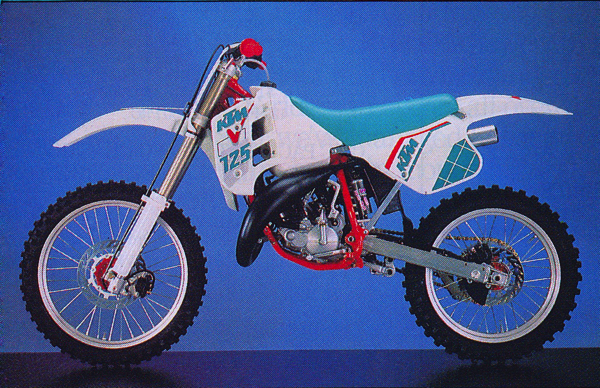 |
|
1991 KTM 125MX Shootout Ranking – MXA 5th (out of five) – Dirt Bike N/A – Dirt Rider 5th (out of five) |
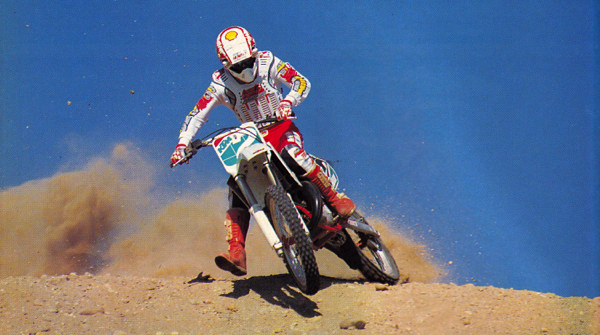 |
|
In 1991, KTM offered a rocket-fast 125, saddled with too much Old World flavor. Photo Credit: Dirt Bike |
1991 KTM 125MX overview: In 1991, there was only one 125 that was capable of keeping the Honda CR125R in its sights on a fast track, and that bike was the KTM 125MX. The little Katoom may have looked old school with its left-side kick and Dell’Orto carb, but there was nothing old about its performance. It cranked out a blast of ponies second only to the hot-rod Honda. Midrange and top-end were excellent and it pulled far past the point where the YZ, RM and KX had thrown out the white flag.
With the KTM, it was not the powerband that was the problem; it was literally everything else. The clutch was absurdly stiff and felt like it had been swiped off the KTM 540 desert sled. The gearbox was notchy and impossible to shift under power. The chassis geometry was weird and the bike was completely uninterested in anything remotely resembling a corner. Both the ergonomics and hardware were less refined than the Japanese and KTM took a lot of time to become comfortable on. The White Power (that is WP to you Millennials) suspension was set up for racing on Mars and offered the least acceptable ride in the class (no small feat against the wrist-punishing Honda). Lastly, the KTM’s brakes were weak, wooden and woefully underpowered.
In short, the KTM was just not set up for America’s tastes in 1991. The bike was a rocket, but the suspension settings, handling and detailing was just not what we were looking for on this side of the pond. In Europe, they certainly proved they could win with riders like Trampas Parker and Bobby Moore at the controls, but over here, they would have to remain a curiosity for another decade.
 |
|
It may have shook its head like a wet basset hound and beat up your wrists like a jackhammer, but nothing was as fast in 1991 as Honda’s CR125R. Photo Credit: Dirt Bike |
For your daily dose of old school moto goodness, make sure to follow me on Instagram and Twitter @tonyblazier
For questions or comments, feel free to drop me a line anytime at TheMotocrossVault@Gmail.com





